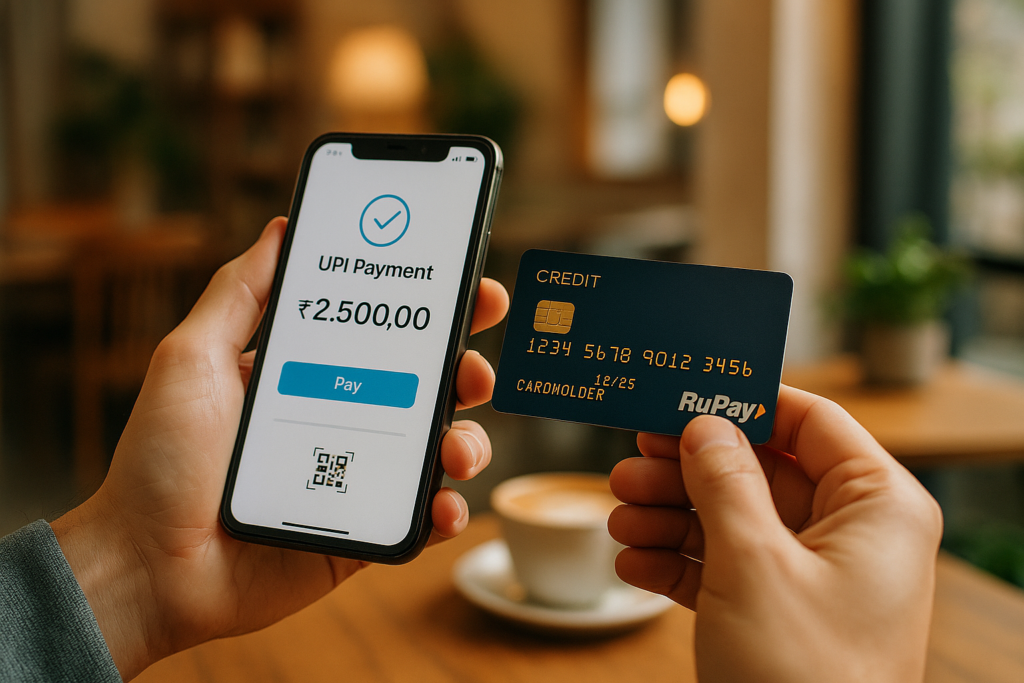Unified Payments Interface (UPI) has transformed digital transactions in India, making money transfers quick and simple. Over time, UPI’s evolution has shifted from just a payments tool to a platform for credit. The recent integration of RuPay-linked credit cards with UPI is a key development in this direction. This integration is not only broadening the scope of digital payments but also increasing the average transaction size, or ticket size, for users. Let’s explore how RuPay credit cards linked to UPI are influencing spending patterns and what benefits this brings to consumers and merchants alike.
Understanding RuPay‑Linked Credit Cards and UPI
RuPay is India’s own card payment network, similar to Visa or Mastercard. In recent years, the National Payments Corporation of India (NPCI) introduced features that allow RuPay credit cards to be used seamlessly with UPI infrastructures. This means you can now link your RuPay credit card directly to your UPI ID, enabling credit transactions through the UPI app.
Prior to this, UPI primarily facilitated direct bank-to-bank transfers. Linking a credit card expands its utility, allowing consumers to make purchases or cash withdrawals using credit, without the need for traditional swipe or chip transactions at physical POS terminals or online checkout pages.
How RuPay‑Linked Credit Cards Are Boosting Ticket Sizes
Several factors contribute to the rise in transaction amounts driven by RuPay credit cards linked to UPI:
1. Instant Credit Access and Convenience
- Users can access instant credit through their RuPay credit card without carrying a physical card or entering card details during online payments.
- This ease of use encourages larger purchases, as consumers feel more comfortable spending higher amounts with the assurance of credit availability.
2. Increased Spending Limits
- Credit cards generally offer higher limits compared to debit cards, allowing users to transact larger amounts.
- Linked with UPI, they facilitate high-ticket transactions in categories like travel, electronics, or luxury goods.
3. Incentives and Cashback Offers
- Many RuPay credit cards come with attractive cashback or reward offers which are applicable when used via UPI.
- This not only incentivizes larger spends but also makes consumers more willing to pay via credit UPI transactions.
4. Enhanced Merchant Acceptance
Businesses increasingly accept UPI payments, and with RuPay credit cards integrated, merchants can process higher-value transactions easily, especially in retail and hospitality sectors.
Comparing RuPay‑Linked Credit Cards and Traditional Payment Methods
| Feature | Traditional Credit Card Payments | RuPay‑Linked UPI Credit Cards |
|---|---|---|
| Payment Method | Swipe, chip, online checkout | Mobile app UPI interface |
| Convenience | Physical card or online input required | Instant payment via QR codes or UPI ID |
| Ticket Size | Variable, often higher in retail/hospitality | Increasing as ease of large payments improves |
| Rewards & Offers | Often more comprehensive | Targeted cashback, bonus rewards via app |
Potential Drawbacks and Cautions
- Limited acceptance in some merchants: Not all vendors accept UPI credit transactions, especially for large sums.
- Security concerns: While UPI is secure, linking credit cards requires safeguards against unauthorized usage.
- Credit management: Easy access to credit might encourage overspending if not monitored properly.
How to Maximize Benefits from UPI‑Linked RuPay Credit Cards
- Choose the right card: Compare credit cards based on reward points, cashback offers, and credit limits. For example, [explore high-reward RuPay credit cards](https://finwitty.com/find-my-card/).
- Use for high-value transactions: Leverage the convenience and limits for big-ticket purchases such as travel bookings, electronics, and online shopping.
- Monitor your spends: Keep track of your credit usage through the UPI app to avoid overspending and interest charges.
- Take advantage of offers: Regularly check for special cashback deals or promotional discounts for UPI credit card transactions.
FAQs about UPI Credit and RuPay Cards
Q1: Is it safe to use RuPay credit cards with UPI?
Yes. NPCI has implemented multiple security layers for UPI transactions, including device authentication and OTPs. However, users should also be cautious and avoid sharing details with unauthorized parties.
Q2: Can I use my RuPay credit card for international transactions via UPI?
Currently, UPI is primarily designed for domestic transactions. For international use, credit cards are usually processed through different networks like Visa or Mastercard.
Q3: How do I link my RuPay credit card to UPI?
You can do this through your preferred UPI app (like Google Pay, PhonePe, or Paytm). Select the Rupay credit card option during the card linking process and verify via OTP.
Q4: What is the maximum transaction limit when using a RuPay credit card on UPI?
The limit varies based on your credit card issuer and the merchant’s acceptance thresholds. Usually, limits are higher than standard UPI transactions, facilitating bigger spends.
Q5: Are there any charges for using RuPay credit cards on UPI?
Most banks do not charge extra for UPI transactions. However, check with your bank as some may levy fees for credit transactions or high-value payments.
If you’re keen on exploring the best credit card options suited for your needs, visit our Find My Card page for personalized recommendations. To stay updated on the latest in digital payments and credit card trends, check out our blog.
Understanding how RuPay‑linked credit cards integrate with UPI can significantly enhance your digital payment experience. As this space evolves, it’s important to stay informed and choose products that maximize your spending power and rewards. Happy shopping!

